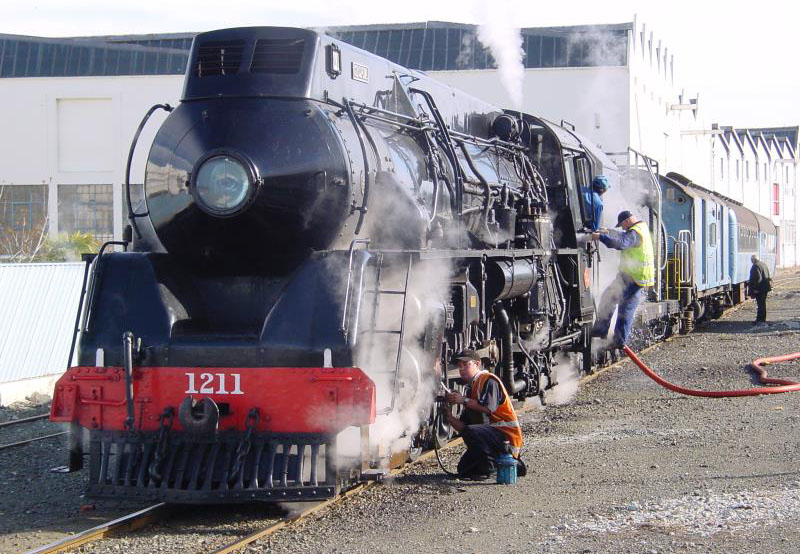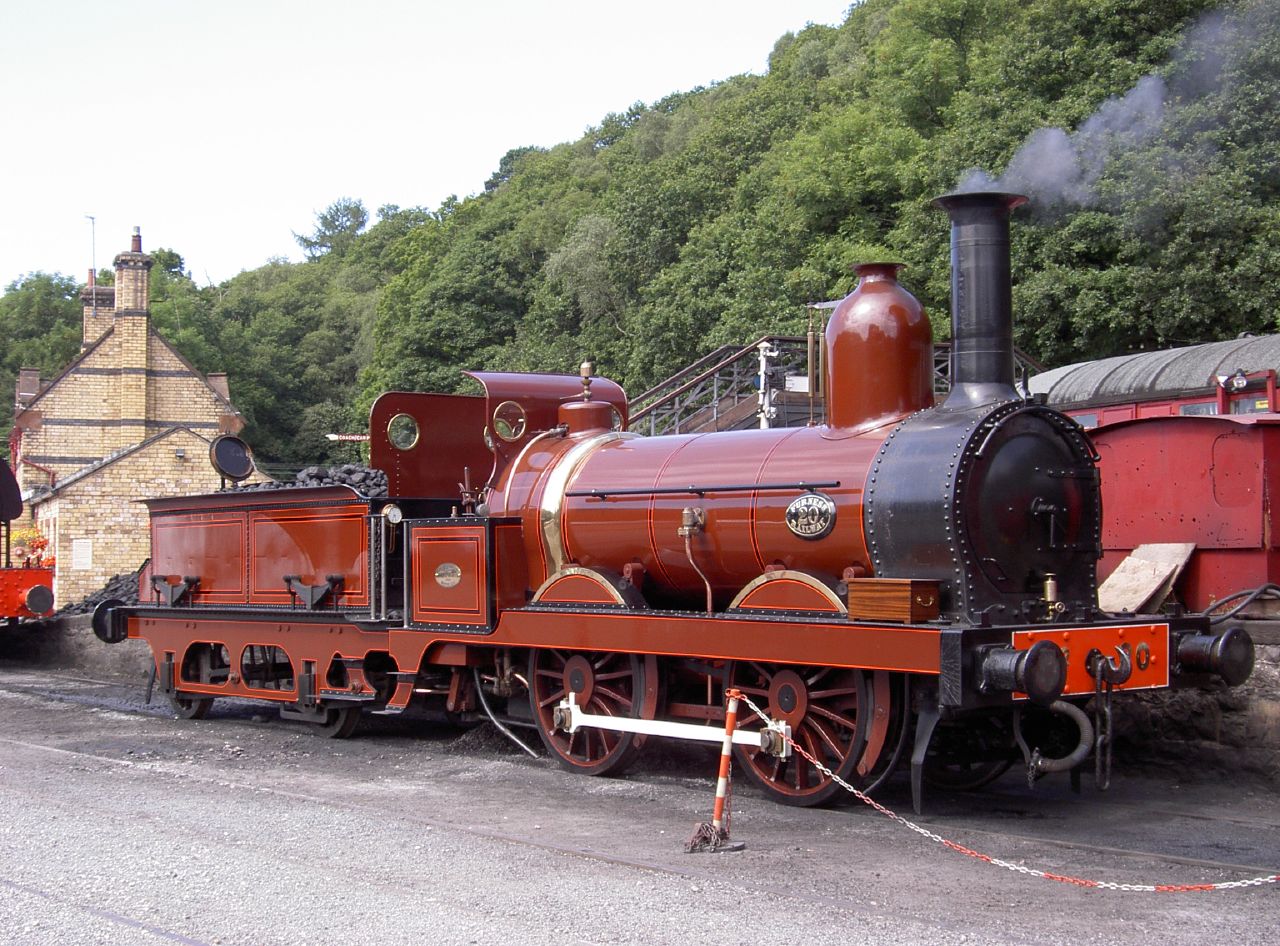|
Neilson And Company
Neilson and Company was a locomotive manufacturer in Glasgow, Scotland. The company was started in 1836 at McAlpine Street by Walter Neilson and James Mitchell to manufacture marine and stationary engines. In 1837 the firm moved to Hyde Park Street and was known as Kerr, Mitchell and Neilson and, in 1840, Kerr, Neilson and Company, becoming Neilson and Mitchell in 1843. Locomotive building began in 1843 for the local railways. In 1855 production of marine and stationary engines discontinued and the company changed its name again to Neilson and Company. Among those who later became notable in the field were Henry Dübs and Patrick Stirling. By 1861, business had increased to such an extent, that a new works was built at Springburn, also named "Hyde Park Works." In 1864, Henry Dübs set up in business on his own at Queens Park Works, as Dübs and Company, taking a number of key staff with him. James Reid, who had previously worked for Neilson, however, returned and becam ... [...More Info...] [...Related Items...] OR: [Wikipedia] [Google] [Baidu] |
Loco21
Loco or El Loco may refer to: Places United States * Loco, Georgia, an unincorporated community * Loco, Oklahoma, a village * Loco, Texas, an unincorporated community * Loco River, Puerto Rico Elsewhere * Loco, Switzerland, a village and former municipality People * Loco (Apache) (1823–1905), Apache chief * Loco (nickname), a list of people known as "Loco" or "El Loco" * Joe Loco (1921–1988), American jazz and pop pianist and arranger * Loco (rapper) (born 1989), South Korean rapper * Locó (footballer) (born 1984), Angolan footballer Manuel Armindo Morais Cange * Daniel Barrera Barrera (born c. 1968), Colombian drug lord also known as El Loco Arts and entertainment Amusement park attractions * El Loco (Adventuredome), a roller coaster at Adventuredome in Las Vegas * El Loco (roller coaster), a type of roller coaster manufactured by S&S Worldwide Fictional characters * Loco (Gobots), in the Gobots toy line * Loco, a grasshopper in the 1998 animated film ''A Bug's Life'' * L ... [...More Info...] [...Related Items...] OR: [Wikipedia] [Google] [Baidu] |
Cowlairs Railway Works
Cowlairs Locomotive, Carriage and Wagon Works, at Cowlairs in Springburn, an area in the north-east of Glasgow, Scotland, was built in 1841 for the Edinburgh and Glasgow Railway and was taken over by the North British Railway (NBR) in 1865. It was named after the nearby mansion of Cowlairs, with both locomotive and carriage & wagon works. It was also the first works in Britain to build locomotives, carriages and wagons in the same place. It was located on the western side of the Glasgow-Edinburgh mainline at Carlisle Street. In September 1904, the Eastfield Running Sheds were built on the other side of the Glasgow-Edinburgh mainline, just to the north of the Cowlairs complex, to maintain locomotives and to free-up more engineering space at Cowlairs Works. They were closed in 1994 but the depot site was redeveloped in 2005 and is once again in use as a maintenance facility for British Rail Class 170, Class 170 trains by First ScotRail. Production The first few locomotives were ... [...More Info...] [...Related Items...] OR: [Wikipedia] [Google] [Baidu] |
General Urquiza Railway
The General Urquiza Railway (FCGU) (in Spanish: Ferrocarril General Urquiza), named after the Argentine general and politician Justo José de Urquiza, is a standard gauge railway of Argentina which runs approximately northwards from Buenos Aires to Posadas, with several branches in between. It was also one of the six state-owned Argentine railway companies formed after President Juan Perón's nationalisation of the railway network in 1948. The six companies were managed by Ferrocarriles Argentinos which was later broken up during the process of railway privatisation beginning in 1991 during Carlos Menem's presidency. The FCGU incorporated the British-owned Entre Ríos Railway and Argentine North Eastern Railway companies, as well as the standard gauge segments of the Argentine State Railway, and its principal lines departed from Federico Lacroze railway terminus in Buenos Aires to the north east through the provinces of Buenos Aires, Entre Ríos, Corrientes, and Misiones. ... [...More Info...] [...Related Items...] OR: [Wikipedia] [Google] [Baidu] |
North British Locomotive Company
The North British Locomotive Company (NBL, NB Loco or North British) was created in 1903 through the merger of three Glasgow locomotive manufacturing companies; Sharp, Stewart and Company (Atlas Works), Neilson, Reid and Company (Hyde Park Works) and Dübs and Company (Queens Park Works), creating the largest locomotive manufacturing company in Europe and the British Empire and the second largest in the world after the Baldwin Locomotive Works in the United States. Its main factories were located at the neighbouring Atlas and Hyde Park Works in central Springburn, as well as the Queens Park Works in Polmadie. A new central Administration and Drawing Office for the combined company was completed across the road from the Hyde Park Works on Flemington Street by James Miller (architect), James Miller in 1909, later sold to Glasgow Corporation in 1961 to become the main campus of North Glasgow College (now Glasgow Kelvin College). The two other Railway works in Springburn were St ... [...More Info...] [...Related Items...] OR: [Wikipedia] [Google] [Baidu] |
Sharp, Stewart And Company
Sharp, Stewart and Company was a steam locomotive manufacturer, originally based in Manchester, England. The company was established in 1843 following the dissolution of Sharp, Roberts & Co.. In 1888, it relocated to Glasgow, Scotland, where it later amalgamated with two other Glasgow-based locomotive manufacturers to form the North British Locomotive Company. Early days Iron merchant Thomas Sharp and mechanical engineer Richard Roberts first formed a partnership, Sharp, Roberts & Co. (about which, see also company section in article on Roberts), to manufacture textile machinery and machine tools. They opened the Atlas Works in Manchester in 1828. They had built a few stationary steam engines, and in 1833 built a locomotive, ''Experiment'' for the Liverpool and Manchester Railway. It was a four-wheeled 2-2-0 with vertical cylinders over the leading wheels. After a number of modifications, three similar locomotives (Britannia, Manchester, and ''Hibernia'') were built in 1834 ... [...More Info...] [...Related Items...] OR: [Wikipedia] [Google] [Baidu] |
Clyde Locomotive Company
The Clyde Locomotive Company was a firm of locomotive manufacturers in Springburn, Glasgow, Scotland. The company was founded in 1884 by Walter Montgomerie Neilson, after he left the partnership of Neilson, Reid and Company in 1876 following a disagreement with James Reid. In 1886, the first locomotives were built; these were a class of eight s for the Highland Railway, known as the ''Clyde Bogies''. Two locomotives built in 1887, which had been ordered by the Girvan and Portpatrick Junction Railway, were delivered to that company's successor, the Ayrshire and Wigtownshire Railway. In 1888, the long established engineering firm Sharp, Stewart and Company wanted to expand, but finding it impossible to extend their existing Atlas Works in Manchester (which had no direct rail access), they decided to move to Glasgow; they bought the Clyde Locomotive Co. and renamed it ''Atlas Works'' after their former premises. When Sharp Stewart amalgamated with other firms in 1903 to form the ... [...More Info...] [...Related Items...] OR: [Wikipedia] [Google] [Baidu] |
Cape Government Railways
The Cape Government Railways (CGR) was the government-owned railway operator in the Cape Colony from 1874 until the creation of the South African Railways (SAR) in 1910. History Private railways The first railways at the Cape were privately owned. The Cape Town Railway and Dock Company started construction from Cape Town in 1858, reaching Eerste River, Western Cape, Eerste River by 1862 and Wellington, Western Cape, Wellington by 1863. Meanwhile, by 1864, the Wynberg Railway Company had connected Cape Town and Wynberg, Cape Town, Wynberg. For the moment, railway development at the Cape did not continue eastwards beyond Wellington because of the barrier presented by the mountains of the Cape Fold Belt. Formation of CGR The discovery of diamonds, and the consequent rush to Kimberley, Northern Cape, Kimberley that started in 1871, gave impetus to the development of railways in South Africa. Shortly afterwards, in 1872, the Cape Colony attained responsible government under the le ... [...More Info...] [...Related Items...] OR: [Wikipedia] [Google] [Baidu] |
4-6-0
A 4-6-0 steam locomotive, under the Whyte notation for the classification of steam locomotives by wheel arrangement, has four leading wheels on two axles in a leading bogie and six powered and coupled driving wheels on three axles with the absence of trailing wheels. In the mid-19th century, this wheel arrangement became the second-most-popular configuration for new steam locomotives in the United States, where this type is commonly referred to as a ten-wheeler.White, John H., Jr. (1968). ''A history of the American locomotive; its development: 1830-1880''. New York, NY: Dover Publications. p. 57. As locomotives pulling trains of lightweight all-wood passenger cars from the 1890 to the 1920s, they were exceptionally stable at near speeds on the New York Central's New York-to-Chicago Water Level Route and on the Reading Railroad's line from Camden to Atlantic City, New Jersey. Overview Tender locomotives During the second half of the nineteenth and first half of the twen ... [...More Info...] [...Related Items...] OR: [Wikipedia] [Google] [Baidu] |
2-6-0
Under the Whyte notation for the classification of steam locomotives, represents the wheel arrangement of two leading wheels on one axle, usually in a leading truck, six powered and coupled driving wheels on three axles and no trailing wheels. This arrangement is commonly called a Mogul. Overview In the United States and Europe, the 2-6-0 wheel arrangement was principally used on tender (rail), tender locomotives. This type of locomotive was widely built in the United States from the early 1860s to the 1920s. Although examples were built as early as 1852–53 by two Philadelphia manufacturers, Baldwin Locomotive Works and Norris Locomotive Works, these first examples had their leading axles mounted directly and rigidly on the frame of the locomotive rather than on a separate truck or bogie. On these early 2-6-0 locomotives, the leading axle was merely used to distribute the weight of the locomotive over a larger number of wheels. It was therefore essentially an 0-8-0 with an un ... [...More Info...] [...Related Items...] OR: [Wikipedia] [Google] [Baidu] |
Great Eastern Railway
The Great Eastern Railway (GER) was a pre-grouping British railway company, whose main line linked London Liverpool Street to Norwich and which had other lines through East Anglia. The company was grouped into the London and North Eastern Railway in 1923. Formed in 1862 after the amalgamation of the Eastern Counties Railway and several other smaller railway companies the served Cambridge, Chelmsford, Colchester, Great Yarmouth, Ipswich, King's Lynn, Lowestoft, Norwich, Southend-on-Sea (opened by the in 1889), and East Anglian seaside resorts such as Hunstanton (whose prosperity was largely a result of the 's line being built) and Cromer. It also served a suburban area, including Enfield, Chingford, Loughton and Ilford. This suburban network was, in the early 20th century, the busiest steam-hauled commuter system in the world. The majority of the Great Eastern's locomotives and rolling stock were built at Stratford Works, part of which was on the site of today's Strat ... [...More Info...] [...Related Items...] OR: [Wikipedia] [Google] [Baidu] |






